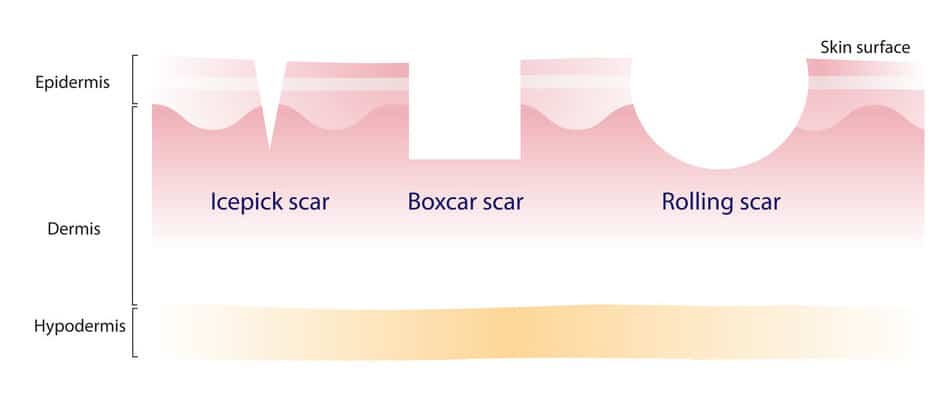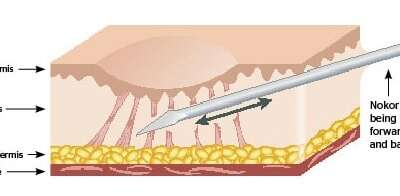Acne Scars – What you need to know
The most dreaded complication of pesky acne, acne scars, is a largely permanent affair. As such, acne itself should be treated as early as possible to prevent the formation of these scars.
Should you already be suffering from the consequences of scarring, many solutions do exist to permanently improve the appearance of these scars.
What Are Acne Scars?
Scars are generally a result of sub-optimal skin healing. This typically occurs after some form of damage to the skin, and can happen from deep scratches, burns, or in this case, acne.
The severity of the pre-existing acne and the inflammation involved usually dictates the severity of the scar, As such, people with more severe forms of acne, such as nodulocystic acne, tend to develop deeper, tougher to treat scars.
There are two broad categories of scars – Atrophic and Hypertrophic scars.
Most acne scars are atrophic and can be categorised into rolling, box, or icepick scars. These scars can also be tethered or untethered to deeper layers. The purpose of this categorisation is to help guide treatment options – each type of scars respond better to certain types of treatment. As such, a single face with multiple types of scars will require a multi-modality approach for ideal outcomes; lasers are not a cure-all for all scars.

Types of Acne Scars
Of the 3 types of acne scars, each might be tethered (anchored) to deeper structures of the hypodermis, and require more invasive procedures to release them from their anchoring scars. This is shown below where a needle is used to release the scars in a procedure known as subcision. This is usually the first step in a series of acne scar treatments where subsequent techniques are used to resurface the more superficial skin and improve its appearance and quality.

Once the scars are free from deeper structures, they are more responsive to other forms of less invasive treatments, including lasers, fractional RF for acne scars or chemical peel treatments.
As mentioned, each type of scar might require a specific type of treatment, and is as follows:
Icepick Scars
Deep scars with a narrow opening, these look like enlarged pores.
Due to the narrow opening, getting lasers to hit the base of the scar is difficult. As such, the recommended modality for such scars is a targeted and very specific one:
- TCA Cross
- Fractional CO2 lasers after TCA Cross
Box Scars
Broad scars with well defined edges and poor skin quality, these box-like scars respond well to the following:
- Fractional CO2 lasers
- Starwalker Fractional laser
- Morpheus 8 Fractional Radiofrequency
Rolling Scars
Undulating and often tethered to deeper surfaces, rolling scars respond well to:
- Subcision with fillers
- Starwalker Fractional laser
- Morpheus 8 Fractional Radiofrequency
- Fractional CO2 lasers
As seen above, some treatment modalities overlap, and some are ideally done after initial subcision or TCA Cross sessions. A thorough consultation and planning of an individualised treatment regimen is therefore advised before embarking on any treatment.
There is no real cookie cutter solution to getting acne scars treated, and acne scar treatments should be viewed as an investment for the long haul – the results are typically permanent, and you want to maximise the gains from each session as much as possible.
Below are details on treatments that directly improve or are indirectly synergistic in acne scar management:
Starwalker Laser System
With the power of a picosecond laser and energy of a Q-switched laser as well as FracTAT fractional resurfacing capabilities, the Starwalker MaQX is capable of managing acne scars with little downtime and potent results.

Lutronic eCO2 & Fotona Dynamis Pro Erbium Lasers
Still the standard in acne scar management, fractional CO2 lasers provide reliable results for those suffering from acne scars.

Morpheus 8
A form of fractional radio-frequency technology, the Morpheus 8 utilises a multi-polar radio-frequency approach to accurately deliver intense energy to the depth of the skin while simultaneously creating a gentle bulk heating of the surrounding skin. This aids in skin tightening and scar remodelling that is safe even in darker skin types.

Fillers
Hyaluronic acid fillers can be used in conjunction with subcision or lasers.
Used during subcision, these fillers separate the upper from lower skin and prevent it from re-attaching, increasing the efficacy of each session.
Used after lasers, the skinbooster (RD 1 with its proprietary nutritious cocktail of aminoacids) aids in recovery of the skin and optimises the end results.

TCA CROSS
TCA CROSS, or Trichloroacetic Acid Chemical Reconstruction of Skin Scars, uses up to 90% strength TCA in minute doses. These drops are placed precisely into icepick scars to stimulate healing within the narrow scars, resulting in resurfacing of these scars over several treatments.

Rejuran Polynucleotides
Harnessing the power of nature, Rejuran employs the use of polynucleotides to stimulate the skin’s natural healing process.
Used in combination with other skin resurfacing techniques or subcision, Rejuran reduces downtime and optimises results for those who want strong outcomes.

Subcision
Scars that are stuck to deeper layers will require subcision – a minor dermatological surgical procedure that uses a needle or blunt cannula to break these anchoring scars.
Done in conjunction with fillers or Rejuran S to prevent immediate readhesion of the freed layers, subcision is typically the first step in a series of treatments for acne scars
Choosing the right combination of treatments can be confusing, and prices can climb if proper prioritisation of treatments is not done.




